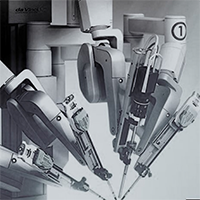 Smart Citations
Smart CitationsSee how this article has been cited at scite.ai
scite shows how a scientific paper has been cited by providing the context of the citation, a classification describing whether it supports, mentions, or contrasts the cited claim, and a label indicating in which section the citation was made.
Robotic surgery of head and neck cancers, a narrative review
Head and neck cancers are the most common cancers in the body. Treatments are determined on the basis of the location and stage of the primary tumor. The goal of treatment is to eliminate the tumor, prevent recurrence or metastasis, and maintain the quality of life. There are several treatments available for the management of head and neck cancers, including surgery, radiation therapy, chemotherapy, new molecular agents, and a combination of them. Transoral robotic technique is a short-time operation using a type of robotic machine in which the patient undergoes anesthesia for a shorter time and the side effects of this operation and the time of hospitalization are less than open surgery. Due to the importance of speed and accuracy in head and neck cancer surgery and the importance of application of robotics in surgery, the present study was designed and implemented to review the application of robotics in the management of head and neck cancers. In this review study, the keywords: application, robotic, surgical, head cancer, transoral robotic surgery (TORS), and neck cancer, were searched in ISI, PubMed, Scopus, Google scholar databases. Related articles written domestically or abroad that have covered areas such as the background of transoral robotic surgery, maintaining organ function and approaches, the advantages and disadvantages of TORS, the affordability of TORS, the combination of TORS with other therapeutic approaches published from 2003 to 2019 were reviewed. The use of robotic surgery for precise operations such as head and neck cancers seems to be essential. More advanced robotic devices are expected to expand the surgery treatment for head and neck cancers as well as the results of using TORS for oncologic optimization and acceptability of results while maintaining organ function and patient's quality of life.
Downloads
How to Cite
PAGEPress has chosen to apply the Creative Commons Attribution NonCommercial 4.0 International License (CC BY-NC 4.0) to all manuscripts to be published.

 https://doi.org/10.4081/ejtm.2020.8727
https://doi.org/10.4081/ejtm.2020.8727





